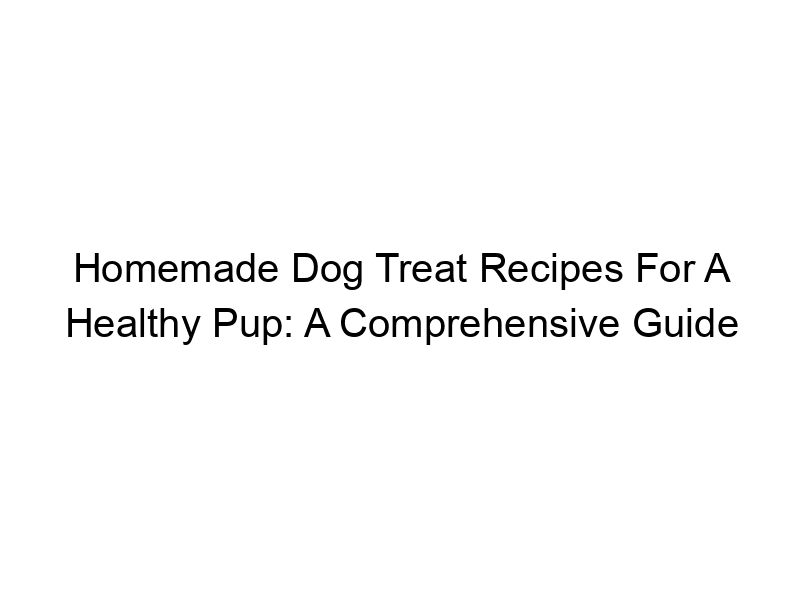Want to spoil your furry friend with healthy, delicious treats made with love? Giving your dog homemade treats is a fantastic way to show your affection and control the ingredients, ensuring they’re getting only the best. This guide will provide you with the best homemade dog treat recipes for a healthy pup, covering everything from basic ingredients and nutritional considerations to advanced recipes and troubleshooting tips. You’ll learn how to create delicious and nutritious treats that your dog will adore, while avoiding harmful additives and unnecessary fillers. Let’s get started!
Before diving into recipes, understanding your dog’s specific dietary needs is crucial. Factors like breed, age, activity level, and any allergies or health conditions will influence the best treat choices. Consult your veterinarian to discuss any dietary restrictions or recommendations.
For example, older dogs might benefit from treats with added glucosamine and chondroitin for joint health, while highly active dogs may need treats with higher protein content.
Essential Ingredients for Healthy Dog Treats
Many common human foods are toxic to dogs. Stick to dog-friendly ingredients like:
- Lean meats (chicken, beef, turkey): Choose lean cuts to minimize fat.
- Sweet potatoes: Excellent source of fiber and vitamins.
- Carrots: Rich in beta-carotene and fiber.
- Apples (without seeds): Provide fiber and vitamins.
- Bananas (in moderation): Source of potassium.
- Plain yogurt (unsweetened): Probiotic benefits (check for xylitol-free).
- Eggs (cooked): Excellent source of protein.
- Oatmeal (plain, uncooked): Provides fiber.
Always avoid ingredients like chocolate, onions, garlic, grapes, raisins, xylitol (artificial sweetener), and macadamia nuts, which are toxic to dogs.
Recipe 1: Simple Peanut Butter and Banana Bites
This recipe is perfect for beginners. It’s easy to make, requires minimal ingredients, and is highly palatable to most dogs.
Ingredients:
- 1 cup whole wheat flour
- 1/2 cup peanut butter (xylitol-free!)
- 1 ripe banana, mashed
- 1 egg
Instructions:
Preheat oven to 350°F (175°C). Combine all ingredients in a bowl and mix well. Roll out the dough to about 1/4 inch thickness. Use cookie cutters to create fun shapes. Bake for 15-20 minutes, or until golden brown. Let cool completely before serving.
Recipe 2: Sweet Potato and Chicken Chews
These chews are longer-lasting and ideal for dogs who enjoy chewing. They provide a good source of protein and fiber.
Ingredients:
- 1 large sweet potato, cooked and mashed
- 1 cup cooked chicken, shredded
- 1/2 cup whole wheat flour
- 1 egg
Instructions:
Preheat oven to 350°F (175°C). Combine all ingredients and mix thoroughly. Roll the dough into a log shape about 1 inch thick. Bake for 30-40 minutes, or until firm. Let cool completely and slice into bite-sized pieces.
Recipe 3: Carrot and Oat Meal Cookies
These crunchy cookies are a healthy and delicious alternative to store-bought treats. They’re packed with vitamins and fiber.
Ingredients:
- 1 cup grated carrots
- 1/2 cup rolled oats
- 1/4 cup whole wheat flour
- 1 egg
- 1 tablespoon honey (optional)
Instructions:
Preheat oven to 350°F (175°C). Combine all ingredients in a bowl and mix well. Drop by spoonfuls onto a baking sheet. Bake for 15-20 minutes, or until golden brown. Let cool completely before serving.
Nutritional Considerations for Homemade Dog Treats
While homemade treats offer control over ingredients, maintaining a balanced diet is crucial. Ensure treats constitute a small percentage of your dog’s daily caloric intake. Too many treats can lead to weight gain and other health issues. Consult your vet for guidance on appropriate treat portions based on your dog’s size, breed, and activity level.
Adapting Recipes to Dietary Restrictions
If your dog has allergies or sensitivities, adjust the recipes accordingly. For example, substitute sweet potatoes for pumpkin if your dog is allergic to sweet potatoes, or use a different protein source if they have a chicken allergy. Always introduce new ingredients gradually to monitor for any adverse reactions.
Storage and Shelf Life of Homemade Dog Treats
Properly storing homemade dog treats is essential to maintain their freshness and prevent spoilage. Store treats in an airtight container in the refrigerator for up to a week. For longer storage, you can freeze them in freezer-safe bags for up to several months.
Comparing Homemade vs. Store-Bought Dog Treats
Homemade treats offer several advantages over store-bought options. You have complete control over ingredients, avoiding artificial colors, flavors, preservatives, and potentially harmful additives. However, homemade treats require time and effort to prepare, while store-bought options offer convenience.
Troubleshooting Common Problems
Homemade dog treats may sometimes turn out dry, crumbly, or too sticky. Adjusting the amount of liquid in the recipe can often resolve these issues. If the treats are too dry, add a little more egg or water. If they’re too sticky, add a bit more flour. Experimentation is key to perfecting your recipes.
Advanced Homemade Dog Treat Recipes
Once you’ve mastered the basic recipes, explore more complex options. Consider incorporating things like different types of meat, vegetables, and even fruits. Get creative with shapes and sizes, but always prioritize healthy and safe ingredients.
Incorporating Supplements into Homemade Treats
With your vet’s guidance, you can incorporate beneficial supplements into homemade treats. For example, adding a small amount of glucosamine and chondroitin can help support joint health in older dogs. Remember to follow dosage instructions carefully and monitor your dog for any adverse reactions.
Using Leftovers Creatively
Don’t waste leftovers! Cooked sweet potatoes or chicken can be easily incorporated into other treat recipes, minimizing waste and adding flavor.
Safety Precautions When Making Homemade Dog Treats
Always ensure all ingredients are thoroughly cooked to avoid bacterial contamination. Avoid using raw meats or eggs in your treats. Always supervise your dog while they’re eating treats to prevent choking hazards.
Exploring Different Baking Methods
Experiment with different baking methods, such as using a dehydrator for a chewier texture or air frying for a crispier treat. Each method will yield slightly different results, so find what works best for your recipe and your dog’s preferences.
Finding the Right Flour for Dog Treats
Various flours are suitable for dog treats, each with slightly different properties. Whole wheat flour is a common choice, but you can also use oat flour, almond flour (ensure it’s dog-safe), or even a combination of flours to achieve desired texture and nutritional benefits.
Dog Treat Recipe Customization: Matching Treats to Your Dog’s Personality
Tailor your recipes to your dog’s individual preferences. Some dogs may prefer softer treats, while others prefer chewier ones. Experiment with different textures and ingredients to find what your furry friend enjoys most.
Frequently Asked Questions
What are the benefits of making homemade dog treats?
Homemade treats allow complete control over ingredients, ensuring your dog avoids artificial additives, preservatives, and potential allergens. It’s a great way to tailor treats to your dog’s specific dietary needs and preferences.
Are there any risks associated with making homemade dog treats?
Improperly cooked treats can pose a bacterial contamination risk. Always ensure all ingredients are thoroughly cooked. Also, be aware of potential allergies and toxic ingredients. Always consult your vet if you have concerns.
How long do homemade dog treats last?
Refrigerated homemade treats typically last for 3-5 days, while frozen treats can last several months. Always check for any signs of spoilage before serving.
What are some common mistakes to avoid when making homemade dog treats?
Using toxic ingredients (chocolate, onions, garlic, etc.), not cooking treats thoroughly, and using excessive amounts of sugar or salt are common mistakes. Always refer to reliable recipes and veterinarian recommendations.
Can I use all types of flour in dog treats?
Not all flours are suitable for dogs. Wheat flour, oat flour, and some nut flours are generally safe, but always check for any potential allergies. Avoid flours containing added sugars or other dog-unsafe ingredients.
How can I determine the appropriate portion size for my dog’s treats?
Treats should only constitute a small portion of your dog’s daily caloric intake. The amount will depend on your dog’s size, breed, and activity level. Consult your veterinarian for specific guidance.
What if my dog has allergies?
If your dog has allergies, adjust recipes accordingly, substituting potentially allergenic ingredients with safe alternatives. Introduce new ingredients gradually to monitor for reactions.
Final Thoughts
Making homemade dog treats is a rewarding experience. It allows you to provide your furry friend with delicious, healthy snacks tailored to their individual needs. By following these guidelines and exploring different recipes, you can create a variety of treats your dog will love. Remember always to prioritize safety, consult your vet with any questions or concerns about your dog’s diet, and enjoy the bonding experience of creating special treats together! Start experimenting today and watch your dog’s tail wag with delight!




